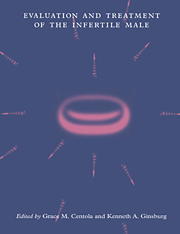Book contents
- Frontmatter
- Contents
- Preface
- List of contributors
- 1 Andrology
- 2 Sperm–egg interaction
- 3 Routine semen analysis
- 4 Computer-aided sperm analysis: a critical review
- 5 Antisperm antibodies: diagnosis and treatment
- 6 The sperm penetration assay
- 7 Intrauterine insemination for male factor
- 8 Processing human semen for insemination: comparison of methods
- 9 New assays for evaluating sperm function
- 10 Assisted reproductive technology for male factor infertility
- 11 Microinjection techniques for male infertility
- 12 Therapeutic donor insemination: screening, indications and technique
- 13 Endocrine assessment and hormone treatment of the infertile male
- 14 The urologic evaluation of the infertile male
- 15 Azoospermia: the diagnosis and treatment
- 16 White blood cells in semen and their impact on fertility
- 17 Psychological aspects of male infertility: lifting the shroud of shame
- 18 Evaluation of the female partner
- Index
12 - Therapeutic donor insemination: screening, indications and technique
Published online by Cambridge University Press: 16 September 2009
- Frontmatter
- Contents
- Preface
- List of contributors
- 1 Andrology
- 2 Sperm–egg interaction
- 3 Routine semen analysis
- 4 Computer-aided sperm analysis: a critical review
- 5 Antisperm antibodies: diagnosis and treatment
- 6 The sperm penetration assay
- 7 Intrauterine insemination for male factor
- 8 Processing human semen for insemination: comparison of methods
- 9 New assays for evaluating sperm function
- 10 Assisted reproductive technology for male factor infertility
- 11 Microinjection techniques for male infertility
- 12 Therapeutic donor insemination: screening, indications and technique
- 13 Endocrine assessment and hormone treatment of the infertile male
- 14 The urologic evaluation of the infertile male
- 15 Azoospermia: the diagnosis and treatment
- 16 White blood cells in semen and their impact on fertility
- 17 Psychological aspects of male infertility: lifting the shroud of shame
- 18 Evaluation of the female partner
- Index
Summary
Introduction
Despite significant advances in both the diagnosis and treatment of male infertility, for some there is still the possibility of unsuccessful medical or surgical therapy. In these situations, and others where no therapy can be offered, when it is refused, or when therapy fails to result in conception, therapeutic donor insemination (TDI) may be the only chance for pregnancy.
Demand for TDI and human semen cryobanking has been increasing world-wide. The number of patients requesting TDI increased four-fold in the United States between 1971 and 1976 (Jacobson, 1976). The process is certainly not new, with observations of the effects of low temperature on spermatozoa being reported by Spallanzani in the eighteenth century. Human semen cryobanking and resulting in vivo fertilization were then reported by Bunge and Sherman in their landmark articles appearing in 1953 and 1954 (Bunge & Sherman, 1953; Bunge et al., 1954). Thirty years later, data compiled by the United States Congress Office of Technology Assessment (US Congress OTA, 1988) estimated that approximately 30 000 births occurred annually as a result of donor insemination. While several factors may account for this tremendous increase in the utilization of donor insemination services (such as increased incidence and prevalence of infertility, greater willingness to utilize TDI by clinicians and fewer adoptive infants), much can be attributed to the established safety and efficacy of cryopreserved donor semen for therapeutic insemination (Table 12.1).
Ten years ago most donor inseminations used fresh semen specimens. Because of concern regarding the transmission of sexually transmitted diseases (STDs), including acquired immune deficiency syndrome (AIDS), practice shifted in the mid-1980s to the exclusive use of cryopreserved semen.
- Type
- Chapter
- Information
- Evaluation and Treatment of the Infertile Male , pp. 171 - 193Publisher: Cambridge University PressPrint publication year: 1996
- 3
- Cited by

